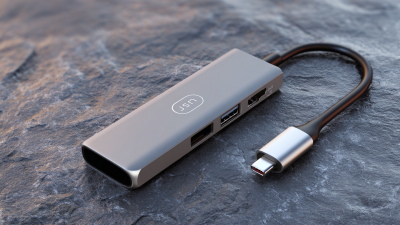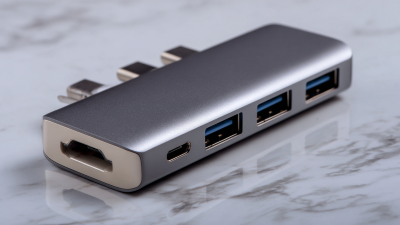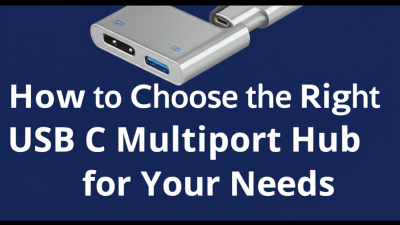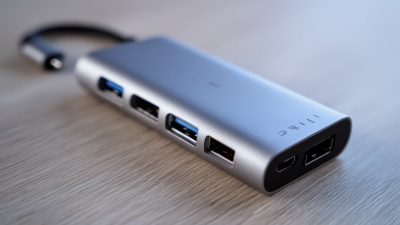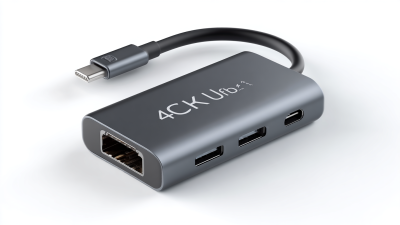
-
Home
-
Products
-
About Us
-
OEM&ODM
-
News
-
Contact Us
Inquiry
Form loading...

In today's fast-paced digital landscape, the need for efficient connectivity has never been more paramount, making the USB Type C Port Hub an essential accessory for technology enthusiasts and professionals alike. As devices become increasingly sophisticated and multifunctional, the versatility and convenience offered by a USB Type C Port Hub can streamline workflows, enhance productivity, and reduce clutter. This ultimate guide will delve into the various types, features, and benefits of USB Type C Port Hubs, highlighting their role in unlocking seamless connections across a multitude of devices. From charging capabilities to data transfer speeds, understanding the nuances of these hubs is vital for maximizing your technology's potential. Join us as we explore the transformative power of the USB Type C Port Hub and how it can revolutionize your everyday tech experience.

 USB Type C has revolutionized the way we connect our devices, offering a plethora of features that enhance user experience. One of the standout characteristics of USB Type C is its reversible design, allowing users to plug the connector in either direction effortlessly. This design eliminates the frustration associated with traditional USB ports, making connections quick and intuitive. Additionally, USB Type C supports a wide range of data transfer speeds, with the capability of reaching up to 40 Gbps, ensuring rapid file transfers and seamless streaming of high-definition content.
USB Type C has revolutionized the way we connect our devices, offering a plethora of features that enhance user experience. One of the standout characteristics of USB Type C is its reversible design, allowing users to plug the connector in either direction effortlessly. This design eliminates the frustration associated with traditional USB ports, making connections quick and intuitive. Additionally, USB Type C supports a wide range of data transfer speeds, with the capability of reaching up to 40 Gbps, ensuring rapid file transfers and seamless streaming of high-definition content.
Another significant advantage of USB Type C is its versatility in powering devices. It can deliver up to 100 watts of power through Power Delivery (PD) technology, allowing not only for charging smartphones and tablets but also for powering laptops and other high-draw devices. This single-port solution simplifies the connectivity landscape, reducing the need for multiple cables and adapters. With its compatibility across various platforms and devices, from smartphones to peripherals, USB Type C is swiftly becoming the universal standard for connectivity in our increasingly digital world.
When considering a USB Type C port hub, it's crucial to prioritize essential features that enhance functionality and usability. According to a recent report by MarketsandMarkets, the USB Type C market is projected to reach $20 billion by 2025, reflecting the growing demand for versatile connectivity solutions. One key feature users should look for is power delivery (PD) support. Hubs that support PD can charge devices at faster rates, with some hubs offering up to 100W of power, which is essential for charging laptops or other power-hungry devices while using them.
Another important feature is the number and types of ports offered. Many contemporary USB Type C hubs come equipped with multiple USB-A, HDMI, Ethernet, and SD card slots, providing the versatility needed for various peripherals. According to a report from Allied Market Research, a majority of consumers prioritize having at least three additional ports on their hubs for seamless multitasking. Additionally, compatibility is vital; ensuring the hub works across various operating systems and devices maximizes investments and ensures ease of use. A well-rounded hub, therefore, not only enhances connectivity but also streamlines workflows in today's increasingly mobile and interconnected world.

When choosing the right USB Type C hub for your needs, it's crucial to consider several factors that align with your lifestyle and usage requirements. Start by identifying the type and number of devices you need to connect. Whether it's a laptop, smartphone, or multiple peripherals like keyboards, mice, or external drives, understanding your connectivity needs will streamline your selection process. Look for hubs with the appropriate ports, such as HDMI, USB-A, and Ethernet, to ensure compatibility with all your devices.
Additionally, consider the data transfer speed and power delivery capabilities of the hub. For users who require fast data transfer rates, USB 3.0 or higher is preferred, while those needing to charge their devices should look for hubs that support power delivery (PD) technology—allowing for simultaneous charging and data transfer.
Finally, evaluate the build quality and portability of the hub. A more durable design can withstand daily wear and tear, while a compact, lightweight hub is ideal for on-the-go users. By assessing these factors, you can find a USB Type C hub that effectively enhances your connectivity experience.
When using USB Type-C port hubs, users may encounter common issues that can impede their productivity. One prevalent problem is the "USB Accessories Disabled" error, especially on Mac devices. This typically indicates a power management issue or incorrect device recognition. To troubleshoot, users should first ensure their hub is properly connected. Disconnecting and reconnecting the devices can help reset the connection. Additionally, checking the system preferences to manage connected devices can enhance functionality.
Another frequent challenge arises with devices not being recognized in operating systems like Windows 11. This is often linked to outdated device drivers or incorrect power settings. Checking for Windows updates and adjusting power management settings in the device manager can resolve these issues. Moreover, ensuring that the USB ports are clean and undamaged is essential for maintaining a stable connection. By following these troubleshooting tips, users can ensure their USB Type-C hubs function efficiently and seamlessly connect a variety of accessories.
When using a USB Type-C hub, maximizing efficiency is essential for seamless connectivity and productivity. A recent industry report indicates that over 80% of consumers are now utilizing devices that support USB Type-C ports, which underscores the significance of having reliable hubs that can enhance the user experience. Key practices involve understanding the capabilities of your hub—ensure it supports Power Delivery (PD) for faster charging, especially for the latest smartphones. For instance, many new devices have advanced charging technology that allows them to recharge significantly faster when paired with the right hub.
Additionally, consider the data transfer speeds your hub can offer. Most Type-C hubs provide USB 3.1 speeds, reaching up to 10 Gbps, which is crucial for efficient file transfers and multitasking. It's advisable to select hubs that feature multiple ports to accommodate various devices, ensuring you can connect external hard drives, displays, and other peripherals without a hitch. With the surge in USB Type-C adoption, leveraging these best practices can significantly enhance your productivity and connection efficiency across all devices.
| Feature | Description | Best Practice |
|---|---|---|
| Port Variety | Includes USB-A, USB-C, HDMI, and Ethernet ports. | Choose a hub with the ports that best suit your devices. |
| Data Transfer Speed | Supports USB 3.1 for high-speed data transfer. | Use devices that also support USB 3.1 for optimal performance. |
| Power Delivery | Allows charging of connected devices up to 100W. | Plug your laptop into the hub for simultaneous charging and use. |
| Compact Design | Portable, lightweight hubs for on-the-go convenience. | Use a compact hub that fits easily in your bag for travel. |
| Compatibility | Works with various operating systems including Windows, macOS, and Linux. | Ensure your operating system is updated for seamless connectivity. |
